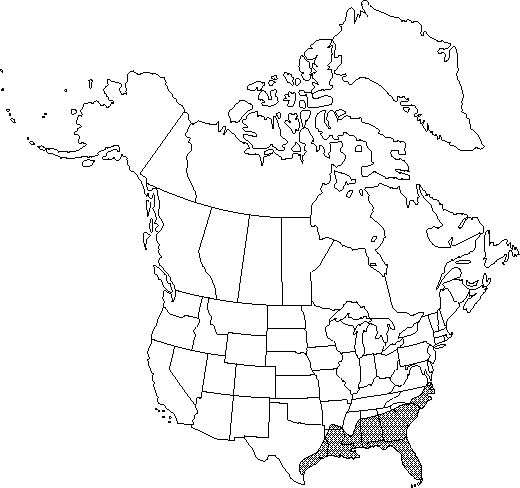Quercus hemisphaerica
Sp. Pl. 4(1): 443. 1805.
Trees, evergreen or tardily deciduous, to 35 m. Bark much like that of Q. laurifolia. Twigs light brown to dark red-brown, 1-2.5 mm diam., glabrous. Terminal buds reddish to purplish brown, ovoid, 2.5-5 mm, glabrous or with ciliate scale margins. Leaves: petiole 1-5(-6) mm, glabrous. Leaf blade narrowly ovate or elliptic to oblanceolate, 30-120 × 10-40 mm, leathery, base obtuse to rounded, rarely attenuate, margins entire or with a few shallow lobes or teeth near apex, awns 1-4 (rarely as many as 8-10 on 2d-flush growth), apex acute or acuminate, occasionally obtuse; surfaces abaxially glabrous, rarely with minute axillary tufts of tomentum, adaxially glabrous. Acorns biennial; cup saucer-shaped to bowl-shaped, rarely turbinate, 3-10 mm high × 11-18 mm wide, covering 1/4-1/3 nut, outer surface puberulent, inner surface pubescent at least 1/2 distance to rim, scales occasionally distinctly tuberculate, tips appressed, acute to obtuse; nut broadly ovoid to hemispheric, 9-16 × 9-16 mm, glabrate, scar diam. 6-9.5 mm.
Phenology: Flowering spring.
Habitat: Moderately dry sandy soils, scrub sandhills, stream banks, occasionally on hillsides and ravines
Elevation: 0-150 m
Distribution

Ala., Ark., Fla., Ga., La., Miss., N.C., S.C., Tex., Va.
Discussion
Quercus hemisphaerica flowers about two weeks later than sympatric Q. laurifolia (W. H. Duncan and M. B. Duncan 1988).
Most authors have treated Quercus hemisphaerica as synonymous with Q. laurifolia. M. L. Fernald (1946) carefully examined the situation and concluded that Q. hemisphaerica is a distinct entity, but C. H. Muller (1951) argued that these two taxa "...are now certainly not separable even as varieties of the same species." Later (1970), Muller recanted by recognizing Q. hemisphaerica as a common component of stream terraces along the Gulf Coast.
Quercus hemisphaerica reportedly hybridizes with Q. falcata (C. H. Muller 1970); with Q. arkansana, Q. inopina, Q. marilandica, Q. myrtifolia, Q. nigra, Q. phellos, Q. pumila, and Q. shumardii (D. M. Hunt 1989); and with Q. incana (producing Q. ×sublaurifolia Trelease), and Q. laevis (producing Q. ×mellichampi Trelease).
Selected References
None.
